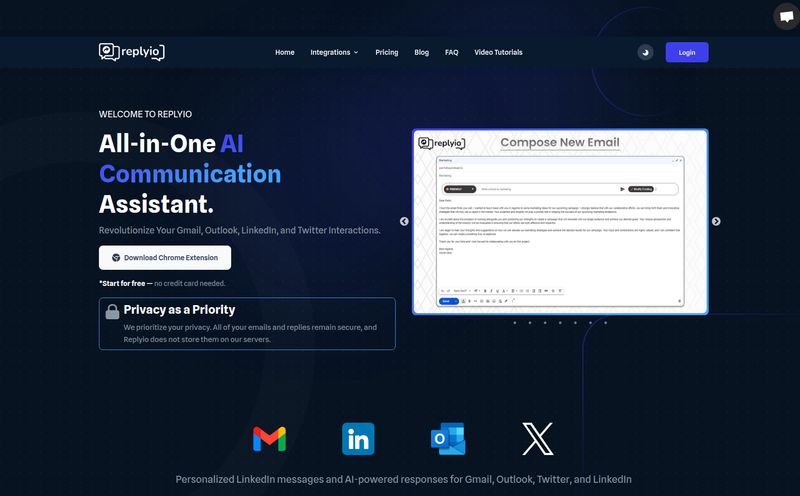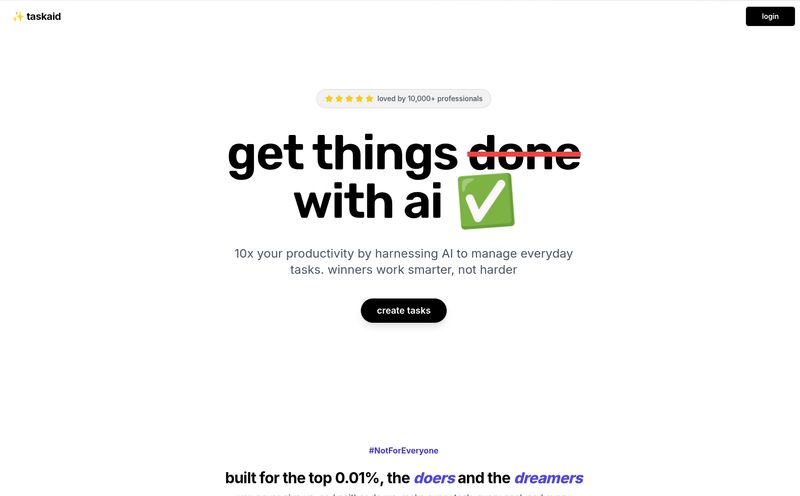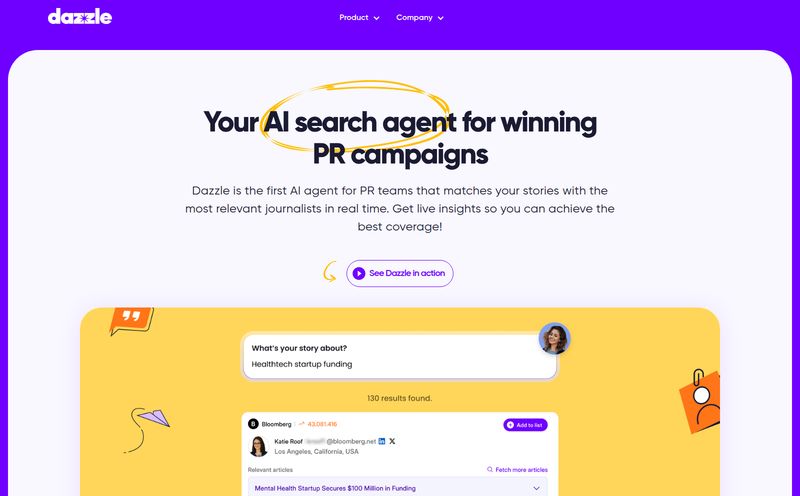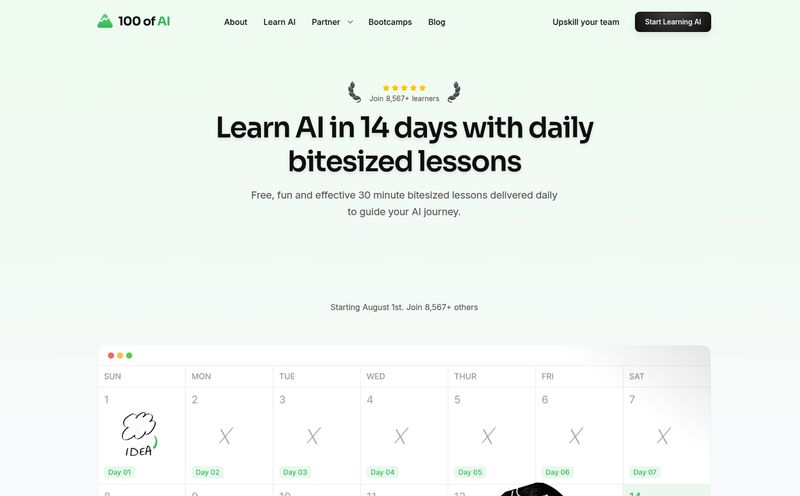My browser tabs are a warzone. I’ve got one for my go-to LLM, another for a different model that’s better at creative copy, a third for generating images, and about five more for various other specialized AI tools I signed up for at 2 AM. It’s a mess. The promise of AI was supposed to be efficiency, but sometimes it feels like I’m spending more time juggling platforms than actually getting work done. We've all felt that tool fatigue, right?
So, when I stumbled upon Polygen, my first reaction was a healthy dose of SEO-jaded skepticism. Another “all-in-one” platform? Sure. But then I looked a little closer, and my curiosity got the better of me. The premise isn't just about bundling things; it’s about creating a coherent workflow. And for a content and traffic guy like me, workflow is everything.
So What Exactly is Polygen?
Think of Polygen as a master key for the best AI engines out there. Instead of you having to hop between ChatGPT, Gemini, Claude, and others, Polygen brings them all under one roof. It’s a unified dashboard, a central command center for your creative and analytical tasks. The idea is simple but powerful: give users access to the best tool for the job, without making them leave the room.
It’s built for both education and business, aiming to help automate tasks, boost user experience, and yeah, save some money. For me, the appeal is having a single place to experiment. Sometimes Claude is better for long-form writing, while Gemini is my go-to for brainstorming structured data. Polygen lets me play them off each other. It’s like having a universal remote for the AI world.
The Features That Actually Matter
A lot of platforms boast a long list of features, but how many of them do you actually use? I was pleasantly surprised by Polygen’s focus. It’s not about quantity; it’s about a few core capabilities that genuinely work together.
More Than Just a Chatbot Graveyard
Having access to several State-of-the-Art (SoTA) LLMs in one spot is the headline act. This solves the “best model” problem. You don’t have to guess which AI will give you the best output for a specific query. You can run your prompt through a couple of them and see what sticks. It's a small change that has a big impact on the quality of my first drafts and marketing angles. No more second-guessing if I'm using the 'right' tool.
The Real Game-Changer: RAG with Containers
Okay, now for the nerdy stuff that really gets my attention. Polygen offers Retrieval-Augmented Generation (RAG) with containers. If you're not familiar with RAG, here’s the gist: it’s like giving an AI a specific, private library to study before it answers your question. Standard AI models know a ton about the public internet, but they know nothing about your business, your project specs, or your internal documentation.
With RAG, you can feed it your own data—a set of blog posts, product descriptions, customer support logs, whatever. The AI then uses that specific information to generate its responses. This is incredible for creating hyper-relevant, brand-consistent content. Imagine an AI that can write a new FAQ page based on your actual support tickets, or draft a case study that perfectly mirrors your brand's tone of voice. This feature alone is worth its weight in gold for serious content operations.
From Text to Voice and Visuals
Polygen also rolls in Text-to-Speech (TTS) and Text-to-Image generation. These aren't just fun add-ons; they're integral parts of the modern content lifecycle. You can write a blog post, then immediately generate a few AI images to go with it. Then, you can use the TTS feature to create an audio version for a podcast or an accessible article reading. It closes the loop. It turns a single idea into multiple assets, all from one platform. That’s real efficiency.

Visit Polygen Studio
The All-in-One Promise: Convenience vs. Cost
So, what’s the damage? This is usually where the dream dies. But Polygen's pricing is refreshingly straightforward. There's no confusing tier system with features held hostage. It’s one plan, with a discount if you pay annually.
| Plan | Price | Billing Cycle | Key Features |
|---|---|---|---|
| Polygen Studio Monthly | $16.99 | Per Month | Access to SoTA LLMs, RAG, TTS, Text-to-Image, Cancel Anytime |
| Polygen Studio Yearly | $169.99 | Per Year | Same features, with a discount equivalent to two months free |
At first glance, $17 a month might seem like just another subscription. But let’s do some quick math. A ChatGPT Plus subscription is $20/month. A decent AI image generator like Midjourney is at least $10/month. Specialized TTS services can also run you $10-$20 a month. Suddenly, getting all of that plus the RAG functionality for under $17 looks like a pretty sweet deal. It's not just about the money, its also about the cognitive load of managing all those separate bills and logins.
An SEO’s Kryptonite? Let’s Talk About That Iframe…
Alright, let's address the elephant in the room. In my research, I saw a potential con mentioned: “The iframe implementation may have SEO and accessibility limitations.” As an SEO professional, my alarm bells went off. So let's break this down.
An iframe is basically a window that displays content from another URL on your webpage. It's often used to embed things like YouTube videos or, in this case, potentially a Polygen-powered tool like a chatbot on your site. The problem is that, historically, search engines like Google have had a tough time “seeing” the content inside an iframe and attributing it to the host page. This could mean any awesome, AI-generated content inside that frame might not contribute to your page's SEO value.
Now, is this a deal-breaker? Not necessarily. Google has gotten much better at processing iframes, as they've stated in their Search Central documentation. However, it's still not a perfect science. My advice? Be strategic. If you're embedding a simple customer service chatbot in the corner of your site, the SEO impact is probably minimal. But if you're planning to use an iframe to display large chunks of core content, I’d be cautious. It’s a classic SEO tradeoff between cool functionality and crawlability. Just something to be aware of—and frankly, I appreciate that this is even something on the radar. It shows a certain technical awareness.
Who is Polygen Actually For?
After playing around and thinking it through, I’ve got a clear picture of the ideal Polygen user. It’s for the scrappy ones. The small business owner, the solo content creator, the digital marketing manager at a startup who’s juggling a dozen responsibilities. It’s for anyone who values time and mental clarity over having a dozen hyper-specialized, and expensive, tools.
If you're an enterprise with a team of data scientists building custom models, this might not be for you. But if you’re a pragmatist who just wants to write a better blog post, generate a cool image for social media, and brief an AI on your company’s new product line without opening 15 tabs… then yes. This is for you. It’s a workhorse, not a show pony.
Frequently Asked Questions about Polygen
- Can I really access models like ChatGPT and Gemini in one place?
- Yes, that’s the main value proposition. Polygen acts as a hub, giving you access to several of the most powerful AI models through a single interface, so you can pick the best one for any given task.
- Is Polygen difficult to learn?
- From what I've seen, it’s designed with an “education forward” and easy-to-use approach. The goal is to simplify your workflow, not add another complex tool you have to spend weeks learning.
- What does "RAG with containers" mean for me?
- In simple terms, it means you can give the AI your own documents to study. This results in more accurate, factually-correct, and brand-aligned answers, because the AI is using your private data as its source of truth, not just the public internet.
- Is the $16.99 monthly fee worth it?
- If you're currently paying for two or more separate AI services (like a chatbot and an image generator), then yes, it’s almost certainly worth it. The price is very competitive, and the time saved from platform-hopping adds even more value.
- Are there any contracts or can I cancel anytime?
- According to their pricing information, you can cancel at any time. This is great for trying it out without a long-term commitment to see if it fits your workflow.
- What are the SEO implications of using Polygen on my website?
- The main consideration is if you use its features via an iframe. While crawlers are improving, content in iframes can sometimes be tricky for SEO. It’s best for embedded tools rather than primary, indexable content. Always a good idea to test and monitor in Google Search Console.
My Final Verdict
I came in skeptical, and I’m walking away pleasantly surprised. Polygen isn’t trying to reinvent the wheel. It’s just building a better car around it. It addresses a very real, very annoying problem for anyone working in the digital space today: tool-sprawl. By consolidating the most useful AI functionalities—multi-model access, RAG, and multimodal content creation—into one clean, reasonably priced package, it makes a compelling case.
No, it’s not a magic button that will solve all your problems. You still need to bring good ideas and a smart strategy. But Polygen is a powerful and practical workbench for bringing those ideas to life. For the price of a few fancy coffees a month, it might just be the thing that cleans up your browser tabs and gives you back a few precious hours in your week. And for me, that's a win.



